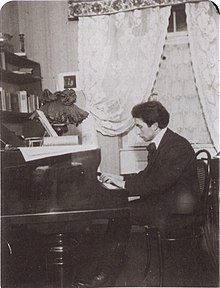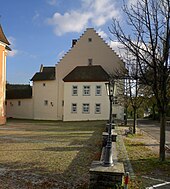Heinrich Kaminski
Heinrich Kaminski (born July 4, 1886 in Tiengen am Hochrhein , † June 21, 1946 in Ried in Upper Bavaria ) was a German composer .
Life
Heinrich Kaminski was born in Tiengen Castle . He was the son of the Old Catholic Pastor Paul Kaminski , who came from Poland and initially wanted to be a Catholic priest, but was one of the leaders of the Old Catholic Secession after the first Vatican . (Old Catholicism took off in Tiengen during the Kulturkampf ; from 1874 to 1883 the Old Catholic parish was awarded the parish church of Maria Himmelfahrt .) His mother was the opera singer Mathilde Barro from Heidelberg. He attended schools in Waldshut, Konstanz and the municipal high school in Bonn. Until he graduated from high school, he lived in the Paulinum , a boarding school of the Old Catholic Church in Bonn. After graduating from high school, he initially worked for a short time as an apprentice in a bank in Offenbach / Main and began studying cameralien (economics) in Heidelberg in 1906 . From the winter semester of 1907/1908, he increasingly steered towards studying music. He attended two lectures in harmony with Philipp Wolfrum . He received his first piano lessons from Johanna Elspermann and from the summer semester of 1907 studied music theory and Protestant church music with Philipp Wolfrum. In 1909 he went to Berlin and began studying music at the Stern Conservatory there and at the Royal Academy. His teachers were Wilhelm Klatte , Hugo Kaun and Paul Juon in composition and piano with the pianist Severin Eisenberger . During this time he wrote his first compositions, the 130th Psalm op.1a and the Quartet in A minor for piano, clarinet, viola and violoncello op.1b (1912) and the string quartet in F major (1913).
In 1914 he started working as a piano teacher in Benediktbeuern . Contemporaries and friends during this period included the painter Franz Marc and his wife, who received piano lessons from Kaminski during this time. In 1921 he met Maria Marc Ada and Emil Nolde in the house, from which a friendship developed. In 1916 he married Friederike Jopp (at Kaminski's request she called herself Elfriede after the marriage), a singer from one of his Munich choirs.
At the time of the First World War Kaminski worked, among other things, as a choir director and composition teacher. Studying with Kaun, which lasted only a few hours, was already ended when he switched to Paul Juon in October 1911. He later received a professorship at the Prussian Academy of the Arts in Berlin, where he became head of a master class for composition; he thus succeeded Pfitzner . His most important students were Carl Orff , Heinz Schubert and Reinhard Schwarz-Schilling . In 1930 Kaminski became music director of the city of Bielefeld . Although the city had to cut the post in 1931 for financial reasons, Kaminiski stayed as a guest conductor in Bielefeld and also became the director of the music association. Because of the increasing influence of the National Socialists on the cultural scene, he withdrew from directing the symphony concerts in Bielefeld in 1933, and in 1934 he also gave up the position of director of the music association.
The takeover of power by the National Socialists shook Kaminski and prompted him to compose a “German Mass” based on his own text, which lamented the “Wirre Welt”. His contract in Berlin expired in 1933, not least because of his "political convictions", without an extension and he went back to Benediktbeuern.
Kaminski's music was initially received largely positively in the Nazi state. In 1938 the Reichsmusikkammer did not raise any objections to his continued membership. On May 24, 1938, Kaminski's string quintet was performed as part of the Reichsmusiktage . Various of his works were also published and performed during the Second World War .
A review of his ancestors - Kaminski was classified as a " half-Jew " in 1938 , he was declared a "quarter Jew " in 1941 - led to a temporary ban on performances. He was forced to flee to Switzerland. At first he stayed with Margrit Lutz, a friend, in Rüdlingen , until Werner Reinhart , an important patron from Winterthur, offered him accommodation on Lake Maggiore. At the end of February 1943, Kaminski offered shelter for one night to Alexander Schmorell , a member of the White Rose resistance group who had been persecuted by the Gestapo , after his escape from Elmau .
Between 1939 and 1945 he had to mourn the loss of three children. Heinrich Kaminski's health deteriorated increasingly in the last years of the war. He devoted all of his energy to working on his opera "The Game of King Aphelius". Kaminski died in 1946 at the age of almost 60, shortly after he was able to finish the work.
Honors
- 1928: Beethoven Prize of the Prussian Academy of the Arts , together with Arnold Mendelssohn
- 1929: Music Prize of the City of Munich
A street was named after him in his hometown of Tiengen. On May 16, 1987, the Heinrich Kaminski Society was founded in Tiengen. She set up a memorial room in the castle.
Works (selection)
Operas
- Jürg Jenatsch Subtitle: A drama based on the story of the same name by CF Meyers , opera in 3 acts, (1927, premiered in Dresden 1929)
- The play of King Aphelius , opera in 5 pictures, a prelude and an aftermath (1946, premiere Göttingen 1950)
Choral music
- The 130th Psalm , motet for mixed choir a cappella (1912)
- The 69th Psalm for tenor, boys' choir, mixed choir and orchestra (1914, revised 1930)
- 6 chorales for mixed choir a cappella (1915)
- O Herre Gott , motet for mixed choir and organ ad libitum (1918, revision 1936)
- Introit and hymn for soprano, alto, baritone, violin, viola, cello, small mixed choir and orchestra (1920)
- Music for the Passion for mixed choir a cappella (1920)
- 3 poems by Joseph von Eichendorff for male choir and instruments (1924)
- Magnificat for soprano, viola, small long-distance choir and orchestra (1925)
- Der Mensch , motet after Matthias Claudius for alto and mixed choir a cappella (1926)
- Man , prologue for speaker, mixed choir and orchestra (1926)
- Die Erde , motet after Zarathustra for mixed choir a cappella (1929)
- The German mass for mixed choir a cappella (1934, unfinished)
Songs
- 3 Cantiques Bretons for voice and piano (1923)
- 3 sacred songs for voice, violin and clarinet (1923)
- Triptych for alto or baritone and organ (1930)
Orchestral music
- Concerto grosso (1923)
- Work for string orchestra (arrangement of the string quintet by Reinhard Schwarz-Schilling, 1927)
- Doric Music (1934)
- Orchestra concert with piano (1936)
- In Memoriam Gabrielae with violin and alto solo (1940)
- Dance Drama (1942)
Chamber music
- Quartet for piano, clarinet, viola and violoncello in A minor op.1b (1912)
- String Quartet in F major (1913)
- String Quintet in F sharp minor (1916)
- Canzona for violin and organ (1916)
- Quintet for clarinet, horn, violin, viola and violoncello (1925)
- Prelude and Fugue for Violin and Organ (1929)
- Music for 2 violins and harpsichord (1930)
- Canon for violin and organ (1931)
- Prelude and Fugue for Viola (1932)
- Piano book in 3 parts (1935)
- Music for violoncello and piano (1935)
- House concert for violin and piano (1940)
- Ballad for horn and piano (1941)
Organ music
- Toccata on the chorale How beautifully the morning star shines for us (1923)
- Choral Sonata (1925)
- 3 chorale preludes (1930)
- Toccata and Fugue in C major (1939)
- Andante in E flat minor (1939)
- Organ chorale "My soul is still" (1940)
Piano music
- Piano book. 3 pieces (1934)
- 10 short exercises for polyphonic piano playing (1935)
- Piano booklet (1948)
literature
- Heinrich Kaminski , ed. by Alexander L. Suder (= composer in Bavaria 11). Schneider, Tutzing 1986.
- Thomas-M. Langner: Kaminski, Heinrich. In: New German Biography (NDB). Volume 11, Duncker & Humblot, Berlin 1977, ISBN 3-428-00192-3 , p. 80 f. ( Digitized version ).
- Hans Hartog: Heinrich Kaminski. Life and work . Schneider, Tutzing 1987, ISBN 978-3-7952-0518-8 .
- Hans-Josef Olszewsky: KAMINSKI, Heinrich. In: Biographisch-Bibliographisches Kirchenlexikon (BBKL). Volume 3, Bautz, Herzberg 1992, ISBN 3-88309-035-2 , Sp. 999-1005.
Web links
- Works by and about Heinrich Kaminski in the catalog of the German National Library
- Works by and about Heinrich Kaminski in the German Digital Library
- Sheet music and audio files by Heinrich Kaminski in the International Music Score Library Project
- Literature about Heinrich Kaminski in the bibliography of the music literature
- Heinrich Kaminski Society
- Jan Henning Müller: The composer as a preacher. (Dissertation, pp. 377–392 contain analysis of Kaminski's 130th Psalm)
- Detailed biography. Website of the church music in Benediktbeuern
- All music autographs in the Bavarian State Library
Individual evidence
- ↑ Memorial plaque on the castle
- ↑ Hans Hartog: Heinrich Kaminski - life and work. Schneider, Tutzing 1987, p. 15
- ^ Ernst Klee : The culture lexicon for the Third Reich. Who was what before and after 1945. S. Fischer, Frankfurt am Main 2007, ISBN 978-3-10-039326-5 , p. 284.
- ↑ Klaus Brannath In: Hefte der Heinrich Kaminski Gesellschaft , Heft X 2015, p. 37.
- ↑ Booklet X of the HKG, 2015, p. 39
- ↑ Booklet X of the HKG 2015, p. 41
- ↑ Book X, p. 43
- ↑ Book X, pp. 49-50
- ↑ Hartog 1987, p. 257
- ↑ Detailed biography (without naming the author). Website of the church music in Benediktbeuren
- ↑ Hartog 1987, p. 27
- ↑ Hartog 1987, pp. 46/47
- ↑ Book X, p. 34
- ↑ Book X, pp. 50-51
- ^ Heinrich Kaminski | 1933 | 1933. Retrieved August 25, 2018 .
- ↑ Fred K. Prieberg : Handbook of German Musicians 1933–1945 , CD-Rom-Lexikon, Kiel 2004, p. 8.553.
- ^ Dümling / Girth: Degenerate Music Catalog for the Düsseldorf exhibition in 1988
- ↑ Fred K. Prieberg: Handbook of German Musicians 1933–1945 , pp. 3.519–3.520.
- ↑ Hartog 1987, pp. 193, 194
- ↑ Lilo Fürst-Ramdohr: Friendships in the White Rose . Verlag Geschichtswerkstatt Neuhausen , Munich 1995. ISBN 3-931231-00-3 .
- ↑ http://hrs.alsfeld.schule.hessen.de/die_schule/Geschwister_Scholl/Verhoerprotocol/Auszuege_aus_den_Verhoerprotokollen_Hans_Scholl_Teil_1.pdf
- ↑ Prussian Academy of Arts, signed PrAdk o791, p. 55 ff.
- ↑ https://www.munzinger.de/search/portrait/Heinrich+Kaminski/0/458.html
| personal data | |
|---|---|
| SURNAME | Kaminski, Heinrich |
| BRIEF DESCRIPTION | German composer |
| DATE OF BIRTH | 4th July 1886 |
| PLACE OF BIRTH | Tiengen (Upper Rhine) |
| DATE OF DEATH | June 21, 1946 |
| Place of death | Kochel am See |


